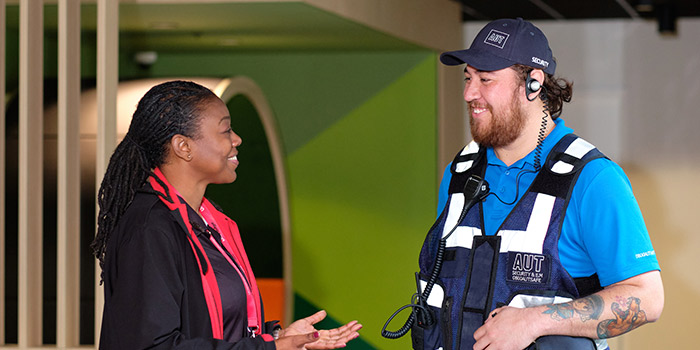Processes and systems around safety, security and emergencies
The safety and security of AUT students and staff are, at all times, of the highest importance. This page provides details about the processes and systems that are in place at AUT.
Security
- AUT has 24/7 on-campus security. Our security control room has eyes on all three campuses through a network of closed circuit TV cameras. This allows the team to monitor and respond to incidents
- In any urgent situation, emergency services should be called on 111
- On campus, our security team is available to assist and can be contacted on 0800 AUT SAFE (0800 288 7233)
Emergencies and EMT
AUT has an Emergency Management Team (EMT) consisting of specialists from across the organisation who come together to manage a range of serious incidents. These include cases of notifiable diseases such as measles and threats to the health and security of our students and staff.
Building evacuation at AUT
- When a building needs to be evacuated, the alarm will sound
- People should immediately leave the building, using stairs not lifts
- Make sure you understand where the gathering point is for the building you're in
- People with accessibility needs are briefed on the way in which they will be assisted in an evacuation depending on their individual needs. Usually they will be accompanied by a staff member who assists them get to the stairway podium on the floor, where they wait for the Fire and Emergency NZ crew
- Follow the instructions of emergency wardens and building wardens
AUT fire alarm text alert
When a fire alarm is activated on campus, AUT students and staff can now opt in for text alerts. It includes the ability to choose the locations, days, times and specific periods during which the user would like to receive text alerts. Users will need to log in using their AUT network login to set this up.
Emergency wardens
Emergency wardens, otherwise referred to as floor/zone wardens, are responsible for the evacuation of occupants from a building and ensuring every occupant reaches the assembly point safely. They will:
- Ensure the evacuation of occupants from a building
- Check all areas to which they are assigned
- Inform people when they need to evacuate
- Report on the state of evacuation to the building warden or emergency services
- Record and report evacuation details
Building wardens
Building wardens are responsible for the overall coordination of an evacuation of a building including communication with floor wardens. They will:
- Establish the nature of an emergency when possible
- Order evacuations when needed
- Ensure that the Fire Service are notified when an alarm is activated
- Control evacuations
- Ensure no one re-enters the building until NZ Fire Service give the all clear
- Collect details from floor wardens
- Delegate duties as necessary: first aid, traffic control, crowd control, isolations
- Report on the state of the evacuation to emergency services
- Record and report evacuation details
Active armed offender situations on campus
Active armed offender (shooter) situations are unpredictable and evolve quickly. Typically, the immediate deployment of police is required, but prior to the arrival of police, how you respond to an active shooter will be dictated by the specific circumstances of the encounter.
Trying to stay calm is important and each person must use their own discretion during an active shooter event as to whether they choose to run to safety or remain in place. Flight/Hide/Tell are the options recommended by the New Zealand Police.
1. Flight
If you can and you deem it safe, get out and get to a safe place
- Have an escape route and plan, try to avoid fleeing across open spaces
- Leave your belongings
- Keep your hands visible
- Attempt to evacuate
2. Hide
Find a place to hide. Find protection.
- Block entry and lock doors
- Remain quiet and silence your cell phone and any other electronic devices
- Close the blinds, turn off the lights, remain quiet, spread out away from other individuals, and move behind available cover. Stay on the floor, away from doors or windows, and do not peek out to see what may be happening.
- If possible and safe to do so, report the location of the assailant to the Police (refer to ‘Active armed offender' section above)
3. Tell
- Call 111
- The more information you can pass onto the police the better, but never at the risk of your own safety or safety of others
What to do if an armed offender enters the classroom
- Try to remain calm
- Try not to do anything that might provoke the shooter(s)
- If there's no possibility of escape or hiding, only as a last resort when it's imminent that your life is in danger should you make a personal choice to attempt to negotiate with or overpower the assailant(s)
- Call 111 if possible
- If the offender(s) leaves the area, barricade the room or proceed to a safer location
Lockdowns on campus
Our campuses are open to the public and the City Campus in particular has many public spaces. Given the nature of this campus the entire area can't be locked down. Individual buildings can be locked, and should that be required, it would be done on instruction from the emergency services and managed from a central point. ‘Lockdown’ effectively means that no one would be able to enter a building, but does not prevent people from leaving a building.
Contact us

Phone: 0800 AUT SAFE (0800 288 7233)
AUT Security and Emergency Management
Email: securitycontrolroom@aut.ac.nz
AUT Facilities Maintenance and Services
Email: ehelp@aut.ac.nz
Have another question on this topic?
Email your question to securitycontrolroom@aut.ac.nz. We’ll add your question and the answer to this list.